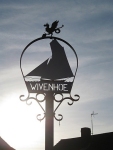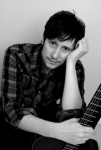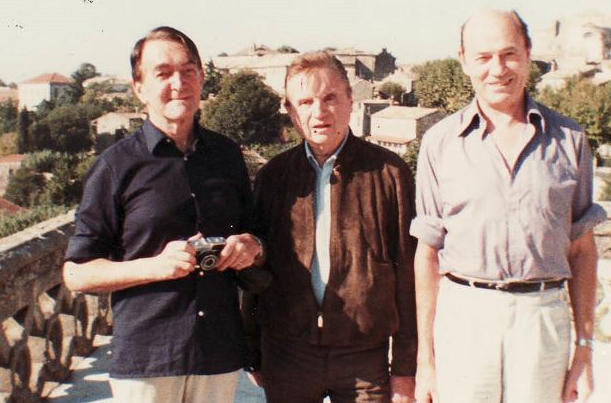by MW Bewick
 It is only a matter of time. Sooner or later, if you get talking to the locals in Wivenhoe, Essex, someone will namedrop Richard Chopping:
It is only a matter of time. Sooner or later, if you get talking to the locals in Wivenhoe, Essex, someone will namedrop Richard Chopping:
“Oh, Dicky and Denis,” they will say. “You don’t know about Dicky and Denis? If you’d been here when they were here… Wivenhoe was much more, well, Wivenhoe then. The tales I could tell…”
The stories of Dicky Chopping and his partner, the painter Denis Wirth-Miller, and their time living in Wivenhoe, are passing into local folklore. The town – which has much more the character of a village (its High Street should be renamed under a trade descriptions act) still appreciates a bohemian. Artists still hole up here, writers and musicians too, while nearby Essex University means that a rotating cast of academics and students from round the world can be spotted amongst the seasoned Essex-folk in the town.
But this is also the place where in the 1970s a faction of the Angry Brigade stayed a while. The University, which was established in the mid-1960s, had quickly gained a well-earned reputation for radicalism that took a long time to shake off. It’s where, until the closure of the docks and shipyards, Russian sailors could be found drinking in the quayside pub, the Rose & Crown. During the miners’ strike in 1984, Wivenhoe made the news as locals, joining forces with miners from Kent, attempted to stop coal being brought through the little port. And, of course, it’s also where one of the true enfants terribles of 20th-century art, Francis Bacon had a house and studio. And, of course, Bacon was a friend of Chopping and Wirth-Miller.There’s a story that Bacon was thrown out of the Wivenhoe Arts Club – it’s often told with a slightly mischievous sense of pride that Wivenhoe was a place with the audacity to throw a giant of the art world out of its own little arts scene. Wivenhoe – it likes to be different. Or, as the poet and musician (and occasionally self-proclaimed Wild Man of Wivenhoe) Martin Newell says: ‘Wivenhoe, the town that psychiatry forgot.’
There’s another line about Wivenhoe: It used to be a fishing town with a small drinking problem: now it’s a drinking town with a small fishing problem.’ In fact, most of Wivenhoe’s pubs have gone the same way as the port. You can see them in black and white photos. Only a few survive. The Rose & Crown, almost next door to Chopping and Wirth-Miller’s beautiful old house on the quay, still does a roaring trade when the sun’s out and the water sparkles and the boats bob. The location is charming, in a scruffy kind of way, and draws in out-of-towners.
Marina Warner is among many who allude to the ‘outrageous’ antics of Dicky and Denis during their younger years in Wivenhoe. In an old piece for the V&A’s website she calls them the ‘roaring boys’. Those who knew them in Wivenhoe like to say the same. Today the town has perhaps lost some of that old fire, yet it flickers still.
It’s often noted how many of the houses in the town have models of boats in their windows. Many others have a sculpture of shorebird, fashioned from driftwood by, or in the style of, artist Guy Taplin, who lives and works in Wivenhoe. In others you glimpse prints by shipwright turned artist James Dodds, who grew up in Brightlingsea a few miles down the estuary, but now also lives and works in the town. Wivenhoe likes its art, but perhaps it likes its art safer than it once did: a little more sanctioned, a little more at arms length. Witness, for example, recent opposition to the town’s disused St John’s Ambulance Hall being redeveloped to house a studio and gallery for ceramicist Pru Green. Of course, once the gallery arrived, with its lovely pots and paintings, the furore faded.
It could be argued that Wivenhoe today is rather like one of Chopping’s own trompe-l’oeil paintings: providing the illusion of the fishing port and artistic hotbed of old, without the salty, inky reality. And yet Wivenhoe is rightly proud of its artistic heritage. It’s not a superficial attachment either; it runs deep in the same kind of way that St Ives in Cornwall, despite the tourist hordes, holds its own artists dear.
Richard Chopping is central to this narrative, but he and Wirth-Miller and Bacon, and Taplin, Newell and the rest who came after, aren’t the cause of Wivenhoe’s strange brew of miniaturised bohemia. They simply found themselves here. Maybe it is because Wivenhoe is a port and brings with it the dilapidation and romance and toughness and far-eyed vision of all ports. Maybe it is the ley line that is said to run nearby. Maybe it is the town’s proximity to London. Whatever the reason, Wivenhoe is lucky to have had Chopping – and if you want to here those outrageous stories of Dicky and Denis, you’ll just have to go.
Incidental Intelligence
 Martin Bewick is a writer and magazine editor and a co-founder of Dunlin Press, which published its first collection of prose and poetry, Est: Collected Reports from East Anglia, in 2015. He has taught at the University of Essex and is a former literary manager at the Blue Elephant Theatre, London. He lives in Wivenhoe.
Martin Bewick is a writer and magazine editor and a co-founder of Dunlin Press, which published its first collection of prose and poetry, Est: Collected Reports from East Anglia, in 2015. He has taught at the University of Essex and is a former literary manager at the Blue Elephant Theatre, London. He lives in Wivenhoe.
A new book entitled ‘THE VISITORS BOOK’ is the untold story of these two fascinating figures to emerge from the turbulent world of post-war British art. It will be released in the spring of 2016 by Constable & Robinson.
Visit http://www.dunlinpress.com
A weekly short story of exactly 100 words by MW Bewick
Denis Wirth-Miller Obituary (The Independent)
![The Wivenhoe Riverfront [wikipedia]](https://literary007.files.wordpress.com/2015/06/wivenhoe_riverfront_2009-10-04.jpg?w=700&h=292)




